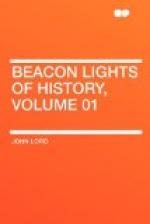It was some time after the settlement of the Aryans on the banks of the Indus and the Ganges before the Vedas were composed by the poets, who as usual gave form to religious belief, as they did in Persia and Greece. These poems, or hymns, are pantheistic. “There is no recognition,” says Monier Williams, “of a Supreme God disconnected with the worship of Nature.” There was a vague and indefinite worship of the Infinite under various names, such as the sun, the sky, the air, the dawn, the winds, the storms, the waters, the rivers, which alike charmed and terrified, and seemed to be instinct with life and power. God was in all things, and all things in God; but there was no idea of providential agency or of personality.
In the Vedic hymns the number of gods is not numerous, only thirty-three. The chief of these were Varuna, the sky; Mitra, the sun; and Indra, the storm: after these, Agni, fire; and Soma, the moon. The worship of these divinities was originally simple, consisting of prayer, praise, and offerings. There were no temples and no imposing sacerdotalism, although the priests were numerous. “The prayers and praises describe the wisdom, power, and goodness of the deity addressed,” [3] and when the customary offerings had been made, the worshipper prayed for food, life, health, posterity, wealth, protection, happiness, whatever the object was,—generally for outward prosperity rather than for improvement in character, or for forgiveness of sin, peace of mind, or power to resist temptation. The offerings to the gods were propitiatory, in the form of victims, or libations of some juice. Nor did these early Hindus take much thought of a future life. There is nothing in the Rig-Veda of a belief in the transmigration of souls[4], although the Vedic bards seem to have had some hope of immortality. “He who gives alms,” says one poet, “goes to the highest place in heaven: he goes to the gods[5].... Where there is eternal light, in the world where the sun is placed,—in that immortal, imperishable world, place me, O Soma! ... Where there is happiness and delight, where joy and pleasures reside, where the desires of our heart are attained, there make me immortal.”
[Footnote 3: Rawlinson, p. 121.] [Footnote 4: Wilson: Rig-Veda, vol. iii. p. 170.] [Footnote 5: Mueller: Chips from a German Workshop, vol. i. p. 46.]
In the oldest Vedic poems there were great simplicity and joyousness, without allusion to those rites, ceremonies, and sacrifices which formed so prominent a part of the religion of India at a later period.
Four hundred years after the Rig-Veda was composed we come to the Brahmanic age, when the laws of Menu were written, when the Aryans were living in the valley of the Ganges, and the caste system had become national. The supreme deity is no longer one of the powers of Nature, like Mitra or Indra, but according to Menu he is Brahm, or Brahma,—“an eternal, unchangeable, absolute being, the soul of all beings,




